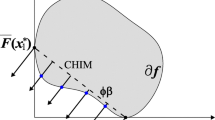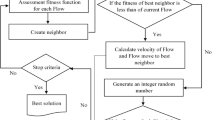Abstract
This paper presents a multi-level procedure for production and injection scheduling through a numerical model-based optimization of well control variables. To calculate the net present value (NPV), the objective function of optimization, this procedure uses a number of discretized systems for a reservoir model with different degrees of up-scaling prepared according to a multi-resolution wavelet technique. These up-scaled models were incorporated into optimization based on a probability function. In early optimization iterations, due to the necessity to explore the search space quickly, the coarsest grid model has a higher chance for selection than the others; however, by a selection (with a low probability) of the finest up-scaled grid model in these iterations, solutions and objective function were tuned. In the later iterations of optimization, the finest up-scaled grid model probability was the highest in order to ensure the reliability of the final solution. The optimization algorithm is an adaptive simulated annealing algorithm coupled with a polytope. This procedure was evaluated in two case studies. The first case study was a horizontal 2D oil model with water flooding. The second case study was a vertical 2D oil model with gas injection. The results show that the proposed optimization procedure provides approximately the same accuracy compared to the situation in which the fine grid model is used for all the optimization iterations. Also, the run-time for the proposed optimization procedure is comparable to the run-time of the optimization in which only the coarsest grid model is used to calculate objective function. Moreover, the superiority of the wavelet-based up-scaling over an analogous multiple grid system optimization using uniformly up-scaled models is presented.

















Similar content being viewed by others
References
Aboufadel, E., & Schlicker, S. (1999). Discovering wavelets. Toronto: Wiley.
Abukhamsin, A. Y. (2009). Optimization of well design and location in a real field. Stanford: Stanford University.
Aliyev, E., & Durlofsky, L. J. (2015). Multilevel field-development optimization using a sequence of upscaled models. In: SPE reservoir simulation symposium. Society of Petroleum Engineers.
Aliyev, E., & Durlofsky, L. J. (2017). Multilevel field development optimization under uncertainty using a sequence of upscaled models. Journal Mathematical Geosciences,49(3), 307–339.
Al-Mufarrej, M. M., Abdel-Basset, M., Al-Mutawa, M., Chetri, H. B., Anthony, E. P., Al Zaabi, H. A., & Harami, K. K. (2017). Integrated and structured production optimization workflow provides robust platform for significant oil gain to a mature oilfield. In SPE middle east oil & gas show and conference. Society of Petroleum Engineers.
Asheim, H. (1988). Maximization of water sweep efficiency by controlling production and injection rates. In: European petroleum conference, London, United Kingdom. Society of Petroleum Engineers.
Azamipour, V., Assareh, M., Dehghani, M. R., & Mittermeir, G. M. (2016). An efficient workflow for production allocation during water flooding. Journal of Energy Resources Technology,139(3), 32902–32912. https://doi.org/10.1115/1.4034808.
Babaei, M., & King, P. R. (2012). A modified nested-gridding for upscaling–downscaling in reservoir simulation. Transport in Porous Media,93(3), 753–775.
Babaie, M. (2013). Multiscale wavelet and upscaling–downscaling for reservoir simulation. London: Imperial College London.
Barragán-Hernández, V., Vázquez-Román, R., Rosales-Marines, L., & García-Sánchez, F. (2005). A strategy for simulation and optimization of gas and oil production. Computers & Chemical Engineering,30(2), 215–227.
Brouwer, D. R., Naevdal, G., Jansen, J. D., Vefring, E. H., & Van Kruijsdijk, C. (2004). Improved reservoir management through optimal control and continuous model updating. In: SPE annual technical conference and exhibition, Houston, Texas. Society of Petroleum Engineers.
Carpenter, C. (2016). Production-optimization strategy using a hybrid genetic algorithm. Journal of Petroleum Technology,68(12), 54–55.
Castro, S. A., Caers, J., & Mukerji, T. (2005). The Stanford Virtual Reservoir. Report 18, Standford Center For Reservoir Forcasting, Stanford University, CA.
Chen, T., Gerritsen, M. G., Lambers, J. V., & Durlofsky, L. J. (2010). Global variable compact multipoint methods for accurate upscaling with full-tensor effects. Computational Geosciences,14(1), 65–81.
Christie, M. A., & Blunt, M. J. (2001). Tenth SPE comparative solution project: A comparison of upscaling techniques. In: SPE reservoir simulation symposium. Society of Petroleum Engineers.
Chu, L., Schatzinger, R. A., & Tham, M. K. (1998). Application of wavelet analysis to upscaling of rock properties. SPE Reservoir Evaluation & Engineering,1(1), 75–81.
de Brito, D. U., & Durlofsky, L. J. (2019). Well control optimization using a two-step surrogate treatment. Paper presented at the arXiv, Math, Optimization and Control. Cornell University, USA.
Durfolsky, L. J. (1991). Numerical calculation of equivalent grid block permeability tensors of heterogeneous porous media. Water Resources Research,27(5), 299–708.
Guan, L., Du, Y., & Li, L. (2004). Wavelets in petroleum industry: Past, present and future. Paper presented at the SPE annual technical conference and exhibition, Houston, Texas, 26–29 September.
Hui, M. R., Karimi-Fard, M., Mallison, B., & Durlofsky, L. J. (2018). A general modeling framework for simulating complex recovery processes in fractured reservoirs at different resolutions. SPE Journal,23(02), 598–613.
Ingber, L. (1996). Adaptive simulated annealing (ASA): Lessons learned. Control and Cybernetics,25, 33–54.
Isebor, O. J., Durlofsky, L. J., & Ciaurri, D. E. (2014). A derivative-free methodology with local and global search for the constrained joint optimization of well locations and controls. Computational Geosciences,18(3–4), 463–482.
Jansen, F. E., & Kelkar, M. G. (1998). Upscaling of reservoir properties using wavelets. Paper presented at the SPE India oil and gas conference and exhibition, New Delhi, India, 17–19 February.
Jessen, K., & Evazi Yadecuri, M. (2013). Simulation of waterflooding with coarse-scale dual-porosity representation of highly heterogeneous reservoirs. Paper presented at the SPE western regional & AAPG Pacific section meeting 2013 joint technical conference, Monterey, California, USA.
Jiang, R., & Durlofsky, L. J. (2019). Implementation and detailed assessment of a GNAT reduced-order model for subsurface flow simulation. Journal of Computational Physics,379(1), 192–213.
Kikani, J., & He, M. (1998). Multi-resolution analysis of long-term pressure transient data using wavelet methods. Paper presented at the SPE annual technical conference and exhibition, New Orleans, Louisiana.
Kirkpatrick, S. (1984). Optimization by simulated annealing: Quantitative studies. Journal of Statistical Physics,34(5–6), 975–986. https://doi.org/10.1007/BF01009452.
Kraaijevanger, J., Egberts, P., Valstar, J., & Buurman, H. (2007). Optimal water flood design using the adjoint method. Paper presented at the SPE reservoir simulation symposium, Houston, Texas, 26–28 February, 2007.
Krogstad, S., Raynaud, X., & Nilsen, H. M. (2016). Reservoir management optimization using well-specific upscaling and control switching. Computational Geosciences,20(3), 695–706.
Lang, J., & Zhao, J. (2016). Modeling and optimization for oil well production scheduling. Chinese Journal of Chemical Engineering,24(10), 1423–1430.
Li, L., & Jafarpour, B. (2012). A variable-control well placement optimization for improved reservoir development. Computational Geosciences,16(4), 871–889.
Liu, Y., & Durlofsky, L. J. (2019). Multilevel strategies and geological parameterizations for history matching complex reservoir models. In SPE reservoir simulation conference. Society of Petroleum Engineers.
Ma, X., Borden, Z., Porto, P., Burch, D., Huang, N., Benkendorfer, P., & Barber, D. F. (2016). Real-time production surveillance and optimization at a mature subsea asset. In SPE intelligent energy international conference and exhibition, Aberdeen, Scotland, UK. Society of Petroleum Engineers.
Mallat, S. G. (1989). A theory for multiresolution signal decomposition: The wavelet representation. IEEE Transactions on Pattern Analysis and Machine Intelligence,11(7), 674–693.
Mamghaderi, A., Bastami, A., & Pourafshary, P. (2013). Optimization of waterflooding performance in a layered reservoir using a combination of capacitance-resistive model and genetic algorithm method. Journal of Energy Resources Technology,135(1), 013102.
Misaghian, N., Assareh, M., & Sadeghi, M. T. (2018). An upscaling approach using adaptive multi-resolution upgridding and automated relative permeability adjustment. Computational Geosciences,22(1), 261–282. https://doi.org/10.1007/s10596-017-9688-2.
Panda, M. N., Mosher, C., & Chopra, A. K. (1996). Application of wavelet transforms to reservoir data analysis and scaling. SPE Journal,5(1), 1–10.
Remy, N., Boucher, A., & Wu, J. (2009). Applied geostatistics with SGeMS: A user’s guide. Cambridge: Cambridge University Press.
Sahimi, M., Rasaei, M. R., Ebrahimi, F., & Haghighi, M. (2005). Upscaling of unstable miscible displacements and multiphase flows using multiresolution wavelet transformation. Paper presented at the SPE reservoir simulation symposium, The Woodlands, Texas, 31 January–2 Feburary.
Saputelli, L. A., Bravo, C., Nikolaou, M., Lopez, C., Cramer, R., Mochizuki, S., & Moricca, G. (2013). Best practices and lessons learned after 10 years of digital oilfield (DOF) implementations. In SPE oil and gas show and conference, Kuwait. Society of Petroleum Engineers.
Sarma, P., Aziz, K., & Durlofsky, L. J. (2005). Implementation of adjoint solution for optimal control of smart wells. In SPE reservoir simulation symposium. Society of Petroleum Engineers.
Sheng, Y. (2000). Wavelet transform. In The transforms and applications handbook (pp. 747–827). The electrical engineering handbook series. Boca Raton: CRC Press.
Shirangi, M. G., Volkov, O., & Durlofsky, L. J. (2018). Joint optimization of economic project life and well controls. SPE Journal,23(02), 482–497.
Tao, L., Qi, L., Shenghuo, Z., & Mitsunori, O. (2002). A survey on wavelet applications in data mining. ACM SIGKDD Explorations Newsletter,4(2), 49–68.
Temizel, C., Kirmaci, H., Wijaya, Z., Balaji, K., Suhag, A., Ranjith, R., & Yegin, C. (2016). Production optimization through voidage replacement using triggers for production rate. In SPE heavy oil conference and exhibition. Society of Petroleum Engineers.
Temizel, C., Nabizadeh, M., Kadkhodaei, N., Ranjith, R., Suhag, A., Balaji, K., & Dhannoon, D. (2017). Data-driven optimization of injection/production in waterflood operations. In SPE intelligent oil and gas symposium, Abu Dhabi, UAE. Society of Petroleum Engineers.
Thyagarajan, K. S. (2011). Still image and video compression with MATLAB. New York: Wiley.
Tiwari, A., Sharma, N. M., Manickavasagam, C., & Fartiyal, P. (2015). Production optimisation in mature fields. In SPE oil & gas conference and exhibition, India. Society of Petroleum Engineers.
Van Essen, G., Van den Hof, P., & Jansen, J. D. (2011). Hierarchical long-term and short-term production optimization. SPE Journal,16(01), 191–199.
Wang, C., Li, G., & Reynolds, A. C. (2009). Production optimization in closed-loop reservoir management. SPE Journal,14(03), 506–523.
Wen, X. H., Durlofsky, L. J., & Chen, Y. (2006). Efficient 3D implementation of local-global upscaling for reservoir simulation. SPE Journal,11(04), 443–453.
Wen, X. H., Durlofsky, L. J., & Edwards, M. G. (2003). Use of border regions for improved permeability upscaling. Mathematical Geology,35(5), 521–547.
Wen, T., Thiele, M. R., Ciaurri, D. E., Aziz, K., & Ye, Y. (2014). Waterflood management using two-stage optimization with streamline simulation. Journal of Computational Geoscience,18(3–4), 483–504.
Wu, X., Efendiev, Y., & Hou, T. Y. (2002). Analysis of upscaling absolute permeability. Discrete and Continuous Dynamical Systems Series B,2(2), 185–204.
Zhang, P., Pickup, G. E., & Christie, M. A. (2008). A new practical method for upscaling in highly heterogeneous reservoir models. SPE Journal,13(01), 68–76.
Acknowledgment
The authors wish to thank the anonymous reviewers for their constructive comments that helped in the improvement of our manuscript.
Author information
Authors and Affiliations
Corresponding author
Rights and permissions
About this article
Cite this article
Azamipour, V., Misaghian, N. & Assareh, M. Multi-level Optimization of Reservoir Scheduling Using Multi-resolution Wavelet-Based Up-scaled Models. Nat Resour Res 29, 2103–2125 (2020). https://doi.org/10.1007/s11053-019-09538-w
Received:
Accepted:
Published:
Issue Date:
DOI: https://doi.org/10.1007/s11053-019-09538-w




